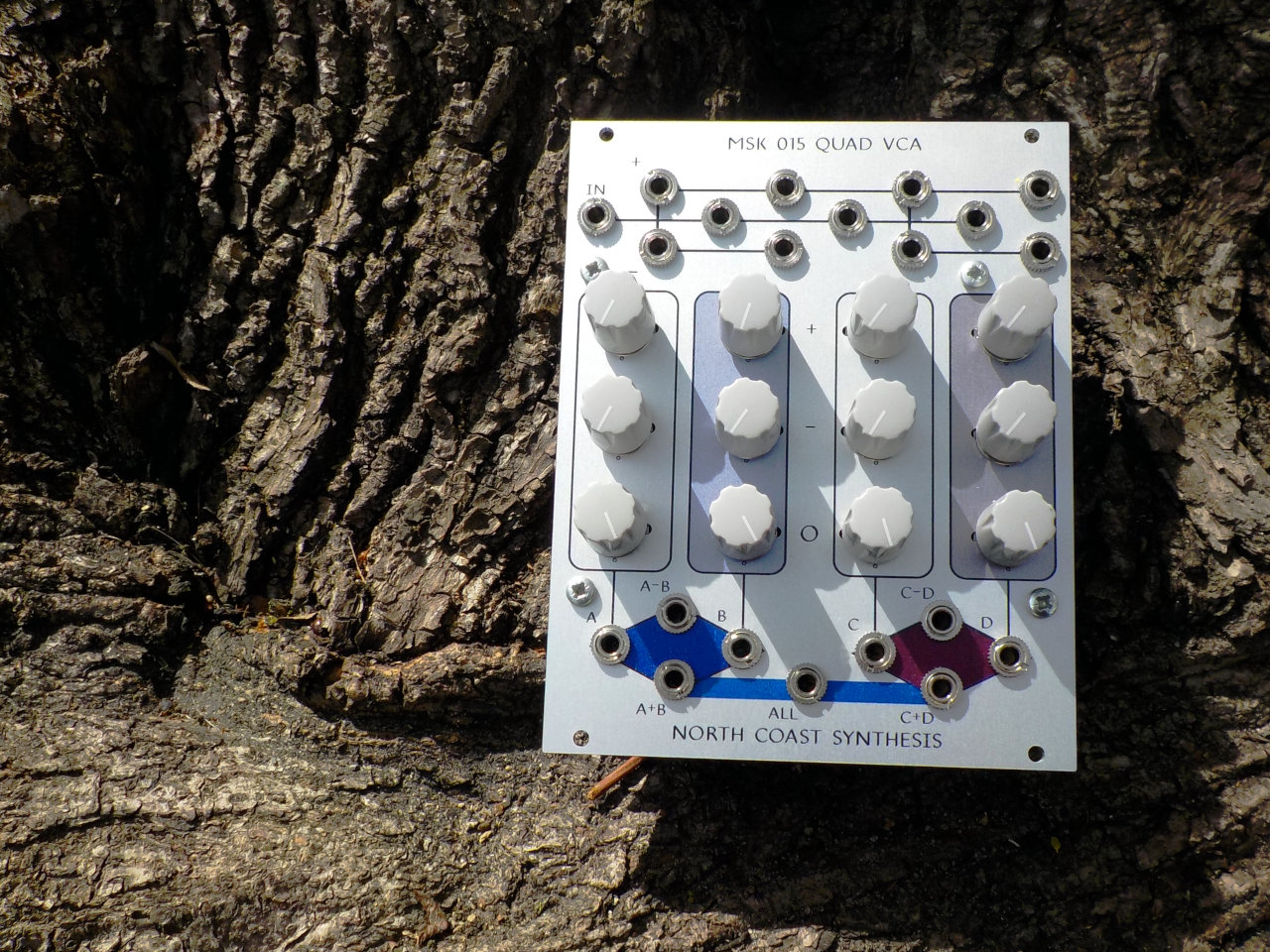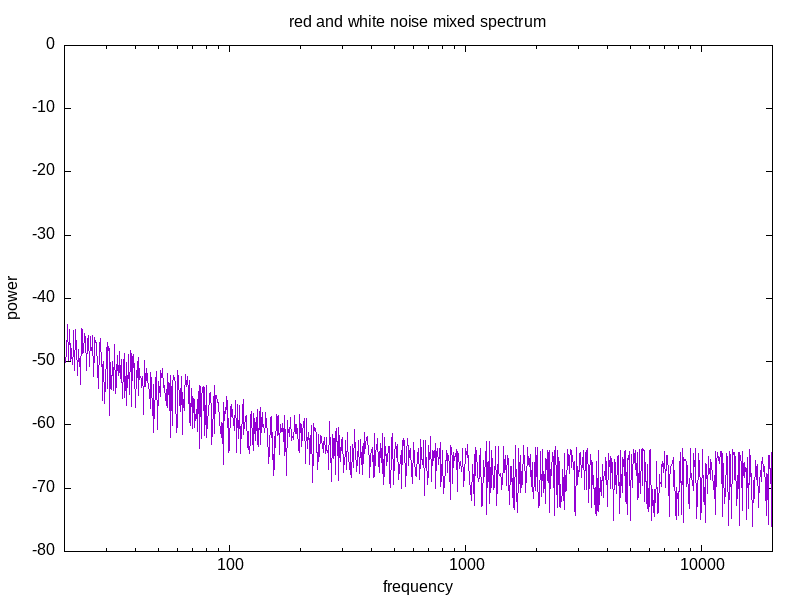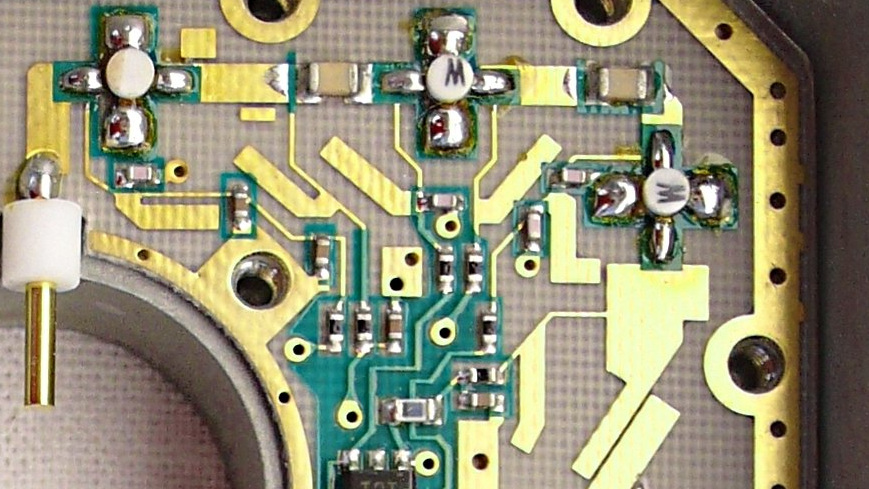Outrunning the Noise Bear
Somewhere in the far North, in fact on the North Coast, the Tenderfoot module was new in town, and a grizzled old A-110-1 was showing him around. As they passed the Rack Brute Saloon, the old timer warned the newcomer about the Noise Bear.
"Gotta watch out for them Noise Bear in this town, kid! Could be lurking 'round any corner. Could be in any patch, waiting just to jump out and getcha."
"The Noise Bear? What does it look like? What does it do?"
"Wa-ell, could be a few different colours, but the Noise Bear is usually white, red, or maybe pink. And when it's stalking you, first thing you hear is kind of a hiss or a rumble. Then if'n you can't get away in time, it'll drag you to the floor and, well, that's it."
The newcomer was starting to be worried. "So, if I hear a hiss or a rumble, I gotta run away? How fast does the Noise Bear move? Can I outrun it?"
"You can't outrun the Noise Bear. It's faster than any module."
"You don't seem too worried. You can't outrun the Noise Bear either!"
"Oh, I don't have to outrun the Noise Bear, kid. When it shows up, I just have to outrun you."
That's a fanciful introduction to an important principle of how noise works in electronic systems like synthesizers. Trying to minimize noise in your modular synthesizer is like outrunning a Noise Bear. If you do it wrong, the bear will "getcha," and most people do do it wrong. But there's some good news too in the fact that the bear only catches the one slowest runner; and the consequences of dealing with it right lead into the topic called "gain staging," which is important when we try to get the best sound quality and lowest noise from audio electronics. Let's think about this in more detail.
The weakest-link principle
There are different names for this principle in different applications, but one good name would be the "weakest link principle." A chain is as strong as its weakest link, which is where it will break if overloaded. Other links don't make the chain any stronger as long as they are just stronger than the one weakest link.
Outrunning the tenderfoot is enough. The bear either gets ya or it doesn't. If you escape the bear, then running even faster doesn't make you escape the bear more.
It's a waste of effort to put extra reinforcements on individual links of a chain, other than the weakest one. You have to strengthen the one weakest link in order to strengthen the chain as a whole. And even if you do strengthen the one weakest link, once you have improved that one link to the point that it's no longer the weakest link, there's no immediate benefit to strengthening the link further. Additional effort would be better spent on whichever has become the new weakest link.
Therefore a well-designed chain will probably end up with all its links of equal strength, or very close; otherwise, a lot of the strength in the links is wasted.
Someone who wants to sell you a single link you can add to your chain, on the claim that it is the strongest single link in the world and that will make your chain meaningfully stronger, is ripping you off. Adding another link to make an existing chain longer, cannot make it stronger. Lengthening the chain can only weaken it, should the new link happen to be weaker than the existing ones; more likely lengthening it has no effect on strength. Replacing an existing link may make the chain stronger, but only if you replaced the weakest link, and then it only makes the chain as strong as the new weakest (former second-weakest) link, not as strong as the ultra-strong replacement link might be.
And if you post a "What is the strongest single link available in 2024?" thread on LinkJiggler Forum where all the chain experts hang out, well.
If you really want an extremely strong chain, then you need to make every single link be one of the special extra-strong links, without exception. If those links are too expensive to use for the entire chain, then you had better not start replacing links incautiously, and should instead re-think whether you really need such a strong chain after all.
Now, let's talk about numbers. Suppose you have two numbers, call them a and b, which are not approximately the same size. One is a fair bit bigger than the other. If you add them together, how big is the result?
The sum is always roughly the size of the larger of the two numbers. For example, 100+1 is 101, which is about 100. Or 0.001+1 is 1.001 which is about 1. A smaller number just doesn't make much difference to a larger number as long as there's a significant gap between their sizes.
I'm talking about the "size" of numbers, more formally the absolute value, modulus, or norm of each number, because this works with negative numbers too, and it even works with complex numbers and vectors. It works with any kind of things that can come in different sizes and can be added to each other with an operation that behaves more or less like normal addition. Add a small thing to a big thing and the small thing basically disappears. We can calculate 1.000 plus (-0.001) and get 0.999 which is about the same as 1.000.
Proof by typography:
Now, if a and b do happen to be about the same size as each other, then all bets are off. With ordinary positive numbers that are equal, their sum will be twice as much. If one is negative and they're the same size, the sum will be zero. With more complicated objects than positive or negative numbers, there are other possibilities. If we require high precision, then too this principle is less useful. It only works when there are significant differences in size among the numbers we're adding up, and we don't care about high precision. But if those conditions apply, then it does work.
The idea that a large number plus a small number equals the large number, approximately, is important in electronics because in electronics we do often deal with numbers of different sizes. It's not unusual that in a synthesizer we have some signals at let's say 7.8mV RMS and some at 1.56V RMS. Those levels, as discussed at length in my article all about levels, are -40dBu and +6dBu respectively.
What is -40dBu plus +6dBu? It is not -34dBu. In fact, -40dBu plus +6dBu is +6dBu. The sum of two different signal levels measured in decibels is basically just equal to the louder one. A jet engine plus a whisper, sounds like a jet engine.
Even if two signals are at the same level, not significantly different, so that the conditions for this principle don't apply, signals still often add at right angles to each other and then the sum ends up being no more than 3dB above the level of the inputs, which is about the same as just equalling the level of the inputs if it's in a context where we are also considering much larger level differences.
What colour was the bear?
Suppose for a moment you actually want to generate noise on purpose. Maybe you want to generate white noise, which has a flat spectrum and sounds like a hiss. It has the same power density at all frequencies.
Maybe you want to generate red noise, with a 6dB/octave (or 20dB/decade, which is easier to see on the chart) roll-off. Red noise sounds like a rumbling growl. It's relatively easy to achieve by using an integrator as a one-pole filter.
Maybe you want to generate pink noise, which has a 3dB/octave (10dB/decade) roll-off. Filters with this kind of roll-off are quite difficult to build in analog, and require some tricky design even in digital, because you're basically asking the circuit or algorithm to perform fractional calculus.
So instead of trying to build a pinking filter (which is the usual name for such a circuit), you just take your white noise output and mix it with your red noise output. This should work, right?
The result is not pink noise, and it doesn't sound like pink noise. It sounds like what it is: a mixture of red and white, which is not the same thing as pink in the context of noise spectra. The reason that mixing noise colours like this doesn't work the way we might want, is because of the math above, and the fact that the scales of the charts are in decibels. There is a corner frequency (around 400Hz on the chart above) below which the slanted red-noise spectrum is louder, and in that range the red noise overwhelms the white and we only see the red noise level shown by a slanted trend line on the chart or hear it when listening to the signal. Above the corner frequency the white noise takes over with its flat spectrum. It is only in a small spectral region around the corner frequency that the two noise colours are about the same level and mixing them is different from just taking the maximum, and even then it's not a whole lot different from just taking the maximum.
It's also because of this effect that we use the term "noise floor." On a spectral analyser display there's likely to be a band near the bottom where the system noise is visible. Anything else, the desired signal and anything like distortion that might be added to it, including new noise sources, either pokes up above the general noise level, or disappears below it. The noise floor represents the lowest level at which anything is intelligible in the signal.
Noise in a system
It's because decibels add by taking the maximum, that the weakest link effect applies to electronic noise. When you're adding up the noise contributions of multiple parts of a system, they will almost certainly be of many different sizes. Some will be bigger than others. And in that case which is the usual case, only the largest noise source or just maybe the largest two or so, matter. No other noise contributions make a difference to the noise at the output. The Noise Bear only catches one module.
In a synthesizer patch where the signal goes through several stages or modules, while the desired signal stays at more or less the same level throughout, each stage or module adds a certain amount of noise, as perhaps measured in millivolts or microvolts RMS. But they probably won't all be adding the same amount. And then whichever one adds the most noise, is the only one that matters.
All too often I see people asking for advice on the "highest quality mixer 2024," the "lowest noise output module 2024," the "cleanest power supply 2024," or similar. It's really striking how these questions always seem to be phrased in superlatives. These people don't just want a good mixer, they want the highest quality mixer. They don't want a low-noise output module, they want the lowest-noise output module, and so on. The year usually turns up on the end of the subject line, too; I'm not sure why. It's not like basic modules such as mixers get revised a whole lot from one model year to the next.
I think people asking for such things are under the mistaken belief that every noise source matters. They know their mixer must be adding some noise, even if other modules are adding noise too; they hear too much noise in their output; and they can only afford to replace one module. So they decide to make that replacement really count, and they want to have just one really nice thing, the highest quality mixer of 2024, expecting it should help a lot. (It had better, for its price tag.)
This thinking is backward. It's an expectation for a chain to be as strong as the strongest link; or at least, for one very strong link to improve the overall strength of the chain. That's just not how chains work; it's not the way the Noise Bear gets ya.
Those seeking a superlative module will never get a useful answer from "LinkJiggler Forum" anyway, but even if they did somehow manage to find and buy the highest quality mixer of 2024, they'd be disappointed. Every noise source in the system does not matter. The weakest link is the link, and the only one, where upgrades make a real difference.
The mixer is probably not the weak link in your system to begin with. Mixers aren't usually very noisy. If it isn't the weak link then replacing it does nothing for overall noise. You just don't hear the mixer, under the floor created by other parts of the system. And even if the mixer did happen to be your weakest link, okay, you replaced it with a much better mixer. And now something else is the weakest link, and limiting your performance. Any pretty good mixer would have helped you with your noise problem just as much as the highest quality mixer of 2024 helped, because pretty good would have been enough to make the mixer no longer the weakest link. Getting the one that was only pretty good would have left you with spare money you could apply to the next module replacement for your next incremental improvement.
Gain staging
It may be difficult to figure out which module is the weakest link in the system; but there are some reasonable principles that can help us make a good guess.
Without going into a lot of details on the many different possible sources of noise (which may be covered in a future article), we can at least say that they are going to be similar in all circuits. One source of noise is thermal fluctuations in resistors and resistive components (Johnson noise). If all the connections in the system are at roughly the same impedance, and they're all at roughly the same temperature, then they will all see about the same number of microvolts of Johnson noise. Similarly, in a component like an IC there will often be more noise than the thermal level, but that amount of noise will be the same for all similar components. A TL074 op amp in one module has about as much noise as a TL074 in some other module; and an AD844 has less noise than that, but still about as much as any other AD844.
To a rough approximation, we can guess that all the modules in the system will be similar in their noise level measured in absolute voltage terms. But the level of the desired signal may not be similar from module to module, and it's the gap or ratio between the desired signal and the noise floor at any point, that matters.
Maybe you have a patch where you amplify a guitar signal from instrument level of -18dBu up to Eurorack level of something like +10dBu. Then you process it through a few effects while keeping it at Eurorack level, and put it through a mixer that knocks the level down to +4dBu professional line level for output. Which module's noise level will determine the system's overall performance?
Any noise in the instrument-level input will be boosted 28dB by the input amplifier, at the same time the desired signal is being boosted 28dB. If there was let's say a -80dBu noise floor on the guitar signal, then that amplifier will have noise in its output at -52dBu. It's unlikely that anything downstream of the input amplifier will have a noise floor so bad as -52dBu. So the weakest link will be the input amplifier, or something upstream of it like a guitar cable. The weakest link won't be the mixer far downstream, with its desired signal output at +4dBu, nor the effects in between with their desired signals at +10dBu. Noise in those stages is unlikely to make a difference. The Noise Bear catches the input amplifier.
It's a good guess in general that whichever stage handles signals at the lowest level, is likely to be the weakest link for noise.
The practice of planning out signal levels and gain between those levels across the different stages of a system, both to keep noise under control and for other reasons, is called gain staging. Although it's less relevant in modular patching than in disciplines like radio, it's still worth knowing and thinking about gain staging at least a little when planning a patch. In general, where possible you want to keep the levels about the same throughout the system, and not have the steps between levels be too large. You want to take your gain at places where it's convenient, which in radio often means at lower frequencies - creating a big part of the justification for "superheterodyne" design.
Radio receivers involve great overall amplification and usually lavish most of their anti-noise efforts on the first few stages of the system. Here's the same public-domain photo I used at the top of my Smith chart article, depicting a close-up microwave circuit board from what is called a "low-noise block downconverter" for a satellite receiver. This board is meant to be mounted actually in the antenna assembly, at the focus of the dish, so that the low-level microwave signal doesn't have to go through a lossy cable.
The signal level from the cylindrical antenna at left is very low, uncomfortably close to the electronics noise floor and the unavoidable thermal noise. Putting it through a long cable to take it to electronics elsewhere would bring the desired signal even lower, because there are no practical low-loss cables for the Ku microwave band. So instead, the signal is only put through about 1cm of microstripline before hitting the first amplifying transistor or MMIC (white pill-like device with four solder connections, at upper left in the photo). At all points beyond that amplifier, the signal is at a higher level, further from the noise floor. By design, the preamplifier device is the "weak link" in the receiving system, and that device, which will have been specially chosen for low noise, determines the noise level for the entire chain. The rest of the downconverter shifts it to a much lower but still "radio" frequency, which can pass through a cable with relatively little loss to get to the rest of the system.
In audio recording, something similar is done with certain kinds of microphones. There's a low-noise preamplifier attached to or built into the mic, with little or no cable in between, and the role of that preamplifier is to be the designated "weakest link" that will determine the noise level of the entire system. All signals downstream from the preamp are at higher levels and the noise in downstream stages is insignificant as long as the preamplifier remains the weakest link.
Finding the weakest link in a synthesizer patch may be more complicated. If the patch does involve amplifying from a low level source like a guitar, fine, that's the place to look. But if it's something like a typical subtractive patch with an oscillator output going through a filter, then it is probable that the level will be about the same throughout. The weakest link is probably not the oscillator because that's the highest level in the patch and a lot of the noise frequencies will be filtered out downstream anyway. If you're using a VCA to articulate notes, then in between notes you want silence, and so the VCA itself and anything downstream of it (where the desired signal level is zero, in between notes) may cause noise issues because that's the lowest level at which the signal is handled.
Sometimes you can make guesses about noise from what you know about the design of a given circuit. For instance, a traditional electromechanical spring or plate reverb has to recover the signal through a pickup that is essentially a microphone, and so it faces all the issues of amplifying from mic level to its output level.
OTA-based VCA stages like the LM13700s built into both the Leapfrog VCF and Coiler VCF, tend to have naturally high voltage gain. Standard design practice for these chips is to knock the signal level down aggressively with a resistive voltage divider and then let the OTA boost it back up. Doing that necessarily brings the signal fairly close to the noise floor; and so these are relatively noisy modules. They are internally handling the signal at a low, sensitive level, a little bit like how the spring reverb works.
But the high gain usually doesn't matter, because some other part of the patch, like a VCA module, will usually end up being the weak link. I also use the LM13700 linearizing diodes in these circuits to reduce the gain, thereby also reducing the amount of attenuation needed and increasing the input level of the chips, keeping the signal a little further above the noise floor. In the case of the Coiler, there are also the coils unavoidably acting as antennas for magnetic interference, which by the weakest link effect means noise in the OTAs usually will not be heard. And, of course, there were important reasons for choosing OTA gain stages in both modules in the first place, which may make their relatively high noise level a justifiable compromise. This introduces my final point about outrunning the Noise Bear.
Get over yourself
All the Noise Bear actually does is hiss at you, or sometimes rumble. How scary is that?
Nobody today listens to the recording of Jimi Hendrix playing the Star Spangled Banner at Woodstock just so they can complain about the hissing and crackling of the 1960s technology that was used to record it. It happened out in the middle of a mud pit full of drugged-out hippies, running late at the end of a festival on a morning when everything was going wrong for the engineers, with hum-prone single-coil guitar pickups, and so on. No part of that recording was made with the highest quality (whatever item) of 2024 and not much of it was even the highest technical quality of 1969. So if you do achieve the best noise specifications of 2024 by spending an arm and a leg on synth modules, with objective "quality" metrics far beyond anything achievable in 1969... are you expecting to sound as good as Jimi, and make music that's arguably still important 55 years later?
Of course such logic can easily be carried too far. It's perfectly natural and reasonable to want to have the best instrument you can get, and as an instrument merchant, I ought to be encouraging you to spend money on that quest as long as you spend it in my shop. But I think it's easy to lose track of the really important thing here, which has to be the music, not the noise. (Noise music exists but that's a topic for another day.) I often want to tell people chasing ultra-low noise levels that their installations are already good enough. A little noise won't hurt you much. Shut up and play your music.
◀ PREV Smith chart by projection || Tickling twonies with triangle waves NEXT ▶







